
In 1967 North Eastern Region was merged into Eastern Region.
| Return to index page |
British Railways (1948/64)
NB The colours used were obtained by sampling colour pictures, they may however vary from the true colour, use as a rough guide only
British Railways was formed in 1948, it was divided into geographical regions loosely based on the pre-war Big Four company areas, Scotland became a region on its own and the former LNER area was divided into North Eastern and Eastern Regions. The regions each had their own colour, normally associated with the enamelled metal station signs (introduced in about 1952), but the goods rolling stock shared a common national standard colour scheme. The regional colours were
Midland Region - MaroonThe illustration below shows a large metal sign set up on the road outside the station and a double sausage 'totem' from a station platforms, both being from Midland Region.
Scottish Region - Light blue
North Eastern Region - Tangerine
Eastern Region - Light Green
Southern Region - Dark Green
Western Region - Brown (although they did try black as an experiment for Western Region signs).
Fig ___ Example of station signs (Midland Region) 
In 1967 North Eastern Region was merged into Eastern Region.
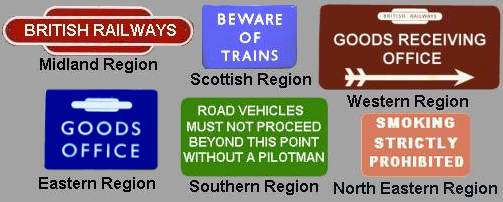
Initially the double-sausage logo was used with BRITISH RAILWAYS inside it to mark vehicles and was sometimes seen mounted on buildings above the station name, the engines originally had the words on their sides in plain white sans serif lettering without the logo. The original circular lion and wheel (or 'lion on a unicycle') logo (A)
appeared in about 1950 and replaced the words BRITISH RAILWAYS on tank and
tender sides. This was in turn replaced by the rampant lion and wheel (or
'ferret and dart board') in 1956 (B). Also in 1956 diesel locomotives received the
D prefix to their number. Passenger stock was often adorned with a round logo (C), I believe some (but not many) of the early DMUs may have had this logo applied.
Fig___ Early BR Logos

The Second World War reduced much of the goods rolling stock to a generally dilapidated state. Following nationalisation in 1948 the remaining pre-war liveried wagons were usually repainted as they passed through the workshops for maintenance and repairs.
Initially British Railways adopted an official basic goods livery of grey for unfitted stock, that is for wagons with only a hand brake, and a red-brown called 'bauxite' for fitted stock, that is for wagons fitted with a vacuum brake. British Railways adopted the vacuum brake as standard and following the 1955 Modernisation Plan, they fitted this to most new stock (other than the steel mineral wagons). The flexible brake pipe connections were red. Some wagons with only a hand brake had pipes and connectors for vacuum brakes, this allowed them to be marshalled into a train of 'fitted' stock. These 'piped' wagons were painted bauxite with white pipe connections.
Originally the unfitted wooden bodied wagons were unpainted, although the wood had a slightly silver look to it when new due to the use of an aluminium primer. This idea was abandoned by the mid 1950's and they were then painted grey. It should be noted that many unfitted pre nationalisation wagons, principally open types, appear to have all paint removed (or worn off), and some had markings reduced to the number painted in the lower left hand corner, generally in black but sometimes white on a black patch. The standard was black underframes and running gear much as used on the LNER, however the solebars, particularly on unfitted stock, were sometimes painted body colour.
Van roofs were initially white, as usual greying in service. According to Dave Larkin's book on British Railways Standard Freight Wagons many vans had black roofs by the late `60's, however I have not traced any official instruction regarding this colour being used and it could perhaps have been simply a very dirty grey.
Lettering was white, and initially consisted of a simple modification to the later Big Four layout. The old company initials in the lower left were replaced by single letter prefix added to the wagon number (which remained unchanged) to indicate which of the pre-grouping companies the stock had come from (M, E, W and S). In the case of the former private owner wagons a letter P was used and the wagons were numbered at random as they came in for painting from P1 to P399999. For British Railways built stock the letter B was used as the prefix to the number. On the grey wagons and vans the lettering did not show up very well, so a black `patch' was introduced onto which the white lettering was applied. This patch also appeared on some of the unpainted wooden bodied stock.
Where mineral wagons were fitted with bottom doors they were indicated by the open V marking as described above. End doors on open wagons were indicated by a 4 inch (10 cm) wide diagonal stripe extending from the bottom corner of the centre door nearest the end-door end to the top corner where the end door hinged.
From about 1957 most of the information, number, load, tare and where applicable special branding, was painted in the lower left of the body, boxed in white lines. The XP for 'fast traffic' vehicles in this system appeared in a separate box, either slightly to the right of the main data panel on the left of the body or separately somewhere on the right of the body side.
This boxed lettering as with all livery changes took time and much of the older stock saw out its life in the earlier style. Also some stock which had not been built until after 1957 seems to have been painted in the old style. There were examples of stock marked with a mix of the two styles, for example with only the new style boxed XP added to older un-boxed lettering.
On special vehicles, such as unfitted iron ore tipplers, the branding was in white on a black patch as shown in the sketch below. Some of these wagons were used to carry stone and possibly other ores in the later 1970's. There is room in the example I have seen for the word IRON to have been written before ORE. The remains of the original square patch was just visible on the wagon side.
Fig ___ British Railways Iron Ore Tippler wagons 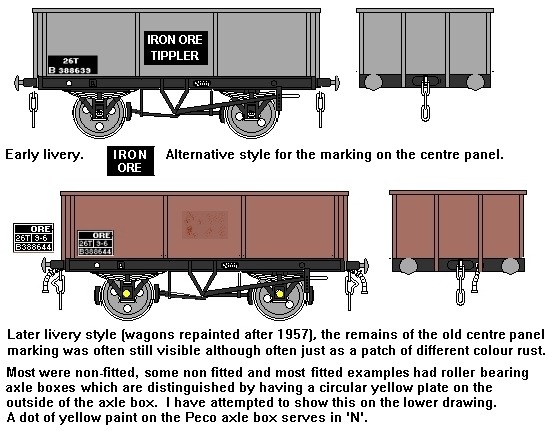
Insulated and refrigerated vans were originally painted white with black lettering, this changed to a light blue (sometimes referred to as `Ice Blue') with white lettering in 1957. Some meat vans were painted a light stone (as used by the SR) in the early British Railways years. The official livery for meat and fish vans and other stock which normally travelled in passenger trains were originally crimson with yellow lettering. In 1957 they changed to maroon with yellow markings and ended up bauxite with white lettering in 1963. An exception to this was the long wheelbase LNER fish van, available from Peco, which was white with black lettering. This had a large blue 'spot' painted to the left of the body as shown.
Fig ___ Ex LNER 'Blue Spot' fish van 
Banana vans, although insulated (to keep the heat in), were painted bauxite. They also sported a yellow disc about eighteen inches in diameter to the left of the body side with the tare weight of the vehicle written on it in black.
Gunpowder vans were in standard freight livery, although the word GUNPOWDER was displayed on the vehicle side and later on the data panel, as shown in the sketches.
Brake vans were either grey for unfitted stock or bauxite when `fitted' with continuous braking and `service stock', ballast wagons, tool vans etc. were painted black with yellow markings, usually with a large letter E. The distinctive GWR type brake van, with the veranda at only one end, was restricted in the main to Western Region rails and had `NOT IN COMMON USE' in white lettering on the side of the body. In practice these did wander however.
Departmental stock was black with yellow markings in this period, although white lettering was sometimes used, mainly on the older vehicles. The vehicle number was prefixed DB for British Railways built examples, DW, DM, DE or DS for absorbed Big Four stock (both purpose built departmental items and vehicles subsequently transferred to that role). When stock was transferred to the engineers department the DB (or whatever) was sometimes painted separately, the wagon retaining its original markings.
There were a range of additional markings applied, a lot of the departmental rolling stock were given 'fish' names as telegraphic codes and these were usually painted somewhere on the side. In some cases further information, such as the ringed CO mentioned under GWR above, was also added. There were also some special brandings painted on for the various departments such as `S&T' for signal and telegraph department stock, although these were not always applied. Do note however that this stock wandered far and wide, even into other regions and characteristic ex Southern Railway or Great Western Railway vehicles could turn up anywhere on the system.
One distinctive BR marking, which appeared in the late 1950's I believe, was
a yellow disk about ten inches in diameter bearing the word Circuit above a
downward pointing arrow. This indicated the vehicle was reserved for a
particular working, such as a van carrying tin cans from the manufacturer to
the cannery. The two locations were painted on the vehicle side below the disk,
I believe these were plain white lettering on fitted (bauxite) stock and white
lettering on a black patch on unfitted (grey) stock but I could be wrong on
that. One way round this is to add a patch of fresh paint below the disk,
indicating that the vehicle has been withdrawn from that particular circuit
working. The earlier markings in the form 'To work between Abc Colliery and Xyz
Power Station' remained in use for some time, a few were seen in the early
1970's. Where stock worked from a single site to a number of locations, for
example sand wagons delivering from a quarry to a range of industries, the old
marking remained in use. Examples would be 'Return To . . .' or 'When Empty
Return To . . .' markings, usually in the lower right of the body, occasionally
on the lower centre of the body (for example on soda ash covhop wagons). The
circuit disk and 'return to' markings were replaced in the early 1970's by a
yellow plate mounted behind the label clip but some stock (minerals and hoppers
mainly if not exclusively) retained the circuit disk, now pointing at the
yellow plate behind the label clip. It perhaps worth mentioning that the labels
used in the label clips were not white but pale brown, pre printed with black
markings and filled in with pencil.
Fig___ Return to and circuit
disk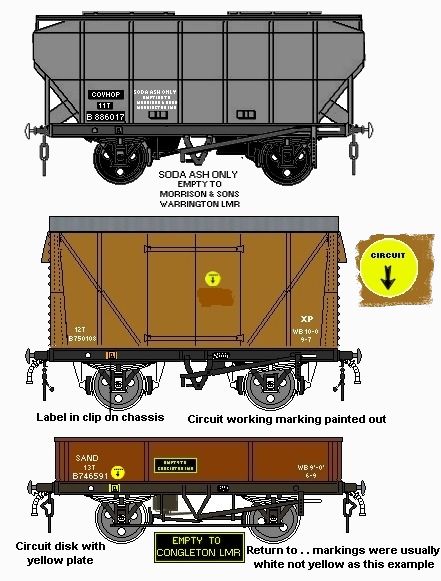
The British Railways 'presflo' wagons were all painted plain bauxite with
white markings, PO examples were painted in the owning company colours and
often had colourful advertising boards mounted on the sides. Some of the BR
wagons were leased out to the cement firms, sometimes these had a stick-on
label applied in one of the square panels on the sides. A small number were
converted in the early 1950's for ferry use (carrying Fullers Earth) by adding
an air brake pipe and securing lugs on the chassis. These do not seem to have
had full ferry markings (I have not yet found a picture of one definitely in
ferry service) but they did have 'BRITISH RAILWAYS' added in the top left 'box'
of the body side. These later reverted to cement traffic but retained the ferry
fittings. There were also a number of privately owned presflo wagons carrying
cement, salt and powdered slate, these are illustrated separately in the
section on PO liveries.
Fig___ BR Presflow Liveries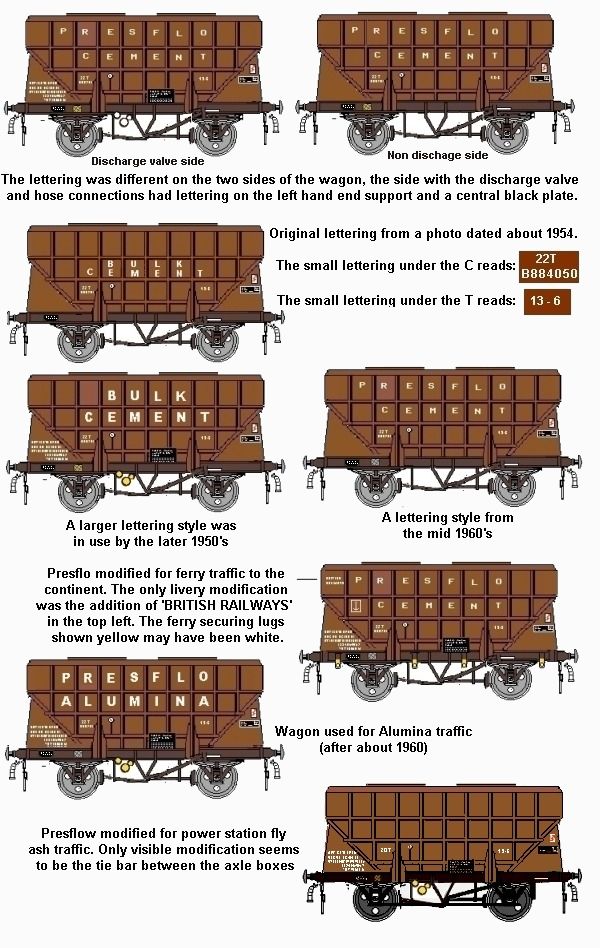
Some presflows were used for power station fly ash traffic and some of these were fitted with air brakes but some examples remained vacuum braked into the early 1980's. These fly ash wagons operated as block trains and were washed down before leaving the power station so they were cleaner than the white-stained cement carriers.

Standard BR markings
In the drawings below you will find a mixture of pre-1957 and post 1957 markings, that is 'boxed' and 'un-boxed' lettering. I have tried to put together a representative sample of vehicles likely to be of interest to the average N Gauge modeller, most of the stock from the pre-war companies was painted in the original un-boxed style and due to the infrequent re-painting of goods stock quite a lot remained in this style into the 1970's.
Fig ___ Early British Railways 'unfitted' liveries on open stock

Fig ___ Early British Railways 'fitted' liveries on open stock
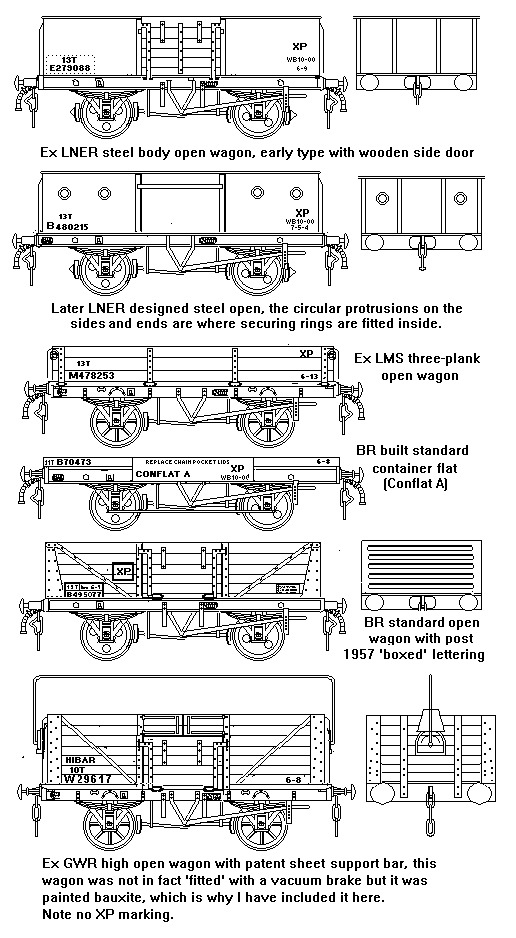
Note, the seven plank ex-GWR open wagon in the lower right is an unfitted wagon, notice no vacuum pipes and no 'XP', however it was painted in bauxite 'fitted' livery as shown. A photo of the original is in Dave Larkin's book on Pre-Nationalisation wagons on British Railways (see Bibliography). These ex GWR vehicles had all disappeared by the end of the 1960's but a few SR seven and eight plank opens survived long enough to be passed to the Engineers department in the 1970's. As mentioned elsewhere the SR eight plank can be made by cutting down a Peco long wheelbase tube body and fitting the door and ends to a Peco 10 foot wheelbase chassis, all the seven plank types can of course be made from Peco seven plan open wagon kits.
Fig ___ Early British Railways liveries for vans and other covered
stock 
Shock-absorbing vans and open wagons had their body mounted on sliding mountings so they could move along the chassis. They were held in place by large coil springs fitted centrally as shown on the sketch below. These were all vacuum fitted and so were painted in standard bauxite but three white stripes on each side and end so staff could identify them easily. Initially these stripes were quite tall and thin, later they were short and fat, as shown on the Minitrix British Railways ventilated van.
Fig ___ British Railways shock absorbing markings. 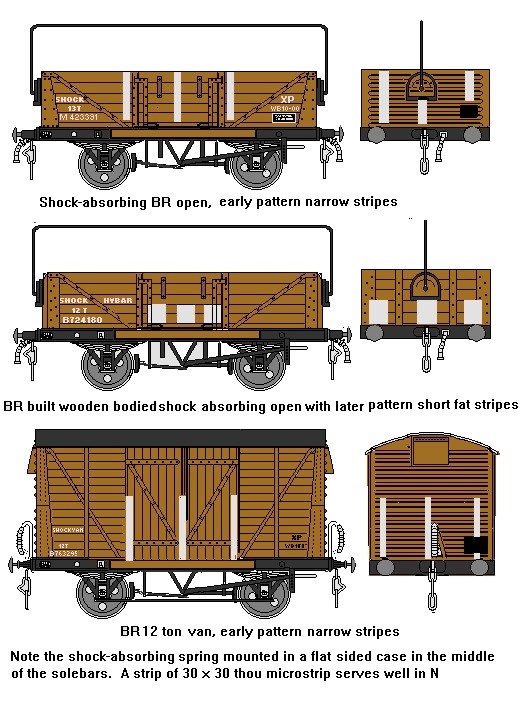
Road vehicles, lorries and vans, were painted crimson with the upper part of the cab and the upper sides of covered vans in cream. I believe these vehicles used white lettering.
Containers used for minerals traffic were painted light grey and this seems to have been standard for open containers such as the D and C types in general. There have been some comments that open containers were originally natural wood with black iron work but I have not traced any photographs to support this. Lettering on the open types was sometimes in black, more often it was in white on a black patch.
Fig ___ British Railways Open Containers. 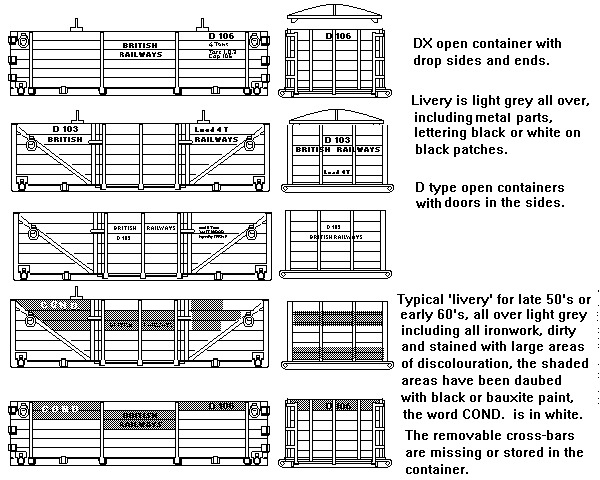
Non insulated standard wooden containers and the early ventilated meat vans were originally painted passenger stock crimson lake with yellow or `straw' lettering. Again this changed first to maroon with yellow lettering in 1957 then bauxite with white lettering in 1961. The insulated containers followed the same pattern of white with black lettering followed by blue with white markings as the insulated vans. Some (although not many) of these older containers were painted in private owner liveries, the containers were owned by the railways but eased to the company.
Fig ___ British Railways Closed Containers 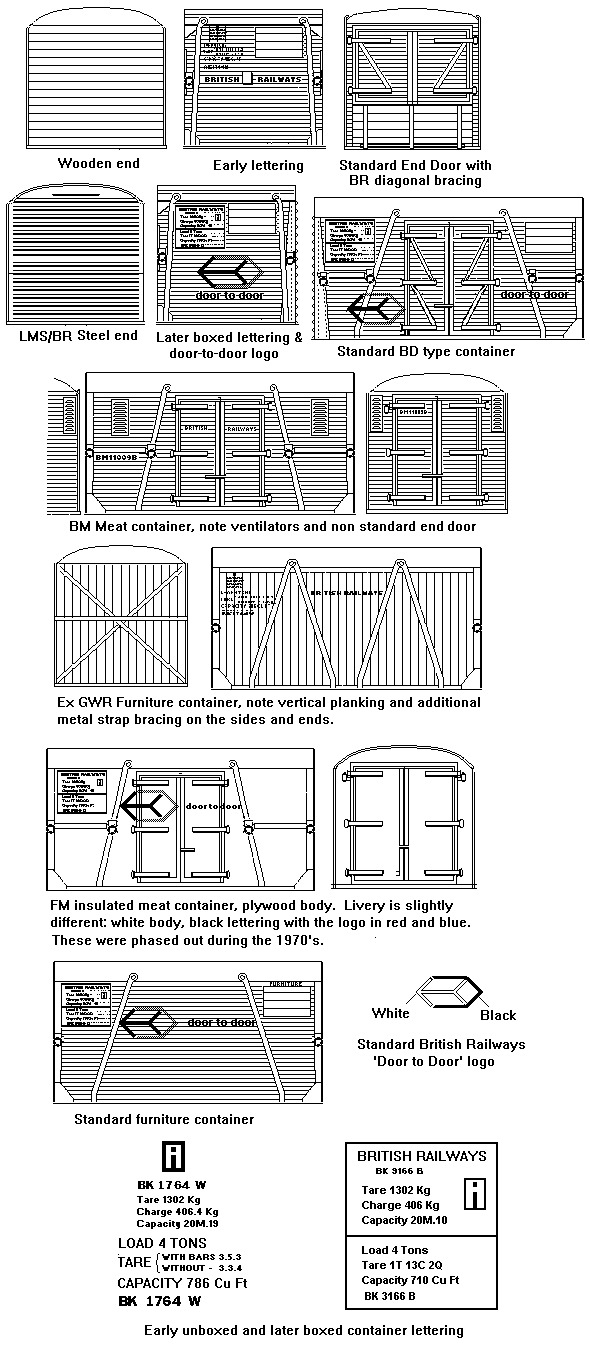
The Speedfreight container service between Manchester and London started in 1961 and initially used containers broadly similar to the old RCH standard B type containers. These wooden containers were (I believe) sometimes painted in the livery of the hiring company, if not the colours were initially as shown below. British Railways also built alloy containers for this service, these were built to two basic designs, one fitted on the Conflat A type wagons, similar to the Peco model but with the pointed Speedfreight securing points. The longer CA type was designed to run on a modified Conflat P, which can be produced using a Peco 15 foot wheel base chassis, although the ends will need a little fettling as these wagons had no floor as such and the container was about three foot (1 m) shorter than the wagon.
Fig ___ Speedfreight containers

The sketch shows various Speedfreight containers in their original British Railways livery. A British Railways (LMR) general purpose closed container (Type BD) using traditional planked construction although built for and painted in the `Speedfreight' livery. The body was standard `freight grey' and the shaded stripe was yellow. The ends seem to have been plain grey. All lettering was black. This container was in service in about 1970. The later alloy types are shown below, the body was in natural metal colour, with a yellow stripe running all the way round the body and the Speedfreight logo and other lettering in black.
The tank container, which ran on one of the modified Plate chassis, was a one-off experimental type, intended for use carrying petrol, it is the only rail tank I know of which used an elliptical shaped tank (rail tank bodies are usually cylindrical in shape) and hunting round toy shops might turn up something suitable. The livery when in service was plain silver with black lettering. The rules at this time were that rail tanks for class A dangerous liquids should be aluminium or dove grey and the chassis should have a red solebar - As it would seem unlikely that a particular chassis would be reserved for such a tank I am not sure how the rules were interpreted, as this was a one-off experimental design however it is possible the wagon was so painted. This container and its associated wagon were subsequently transferred to departmental service when the tank body was painted light grey and an illustration may be found in Dave Larkin's book on British Railways Departmental Rolling Stock details of which will be found in the bibliography. The tank design was probably a failure because it was not allowed to use gravity discharge via a bottom valve (that being illegal on rail tanks) and petrol stations use gravity discharge to get the petrol into their underground tanks.
Following the change to 'corporate livery' in 1964 the colours used on these containers changed to pale grey with a red stripe and white and black markings (this livery is shown in the Livery - British Rail (Pre TOPS - 1964-1975) section.
The drawing below shows the markings on standard Speedfreight wagons, the livery was black with white lettering.
Fig ___ Conflat wagons used for the Speedfreight service
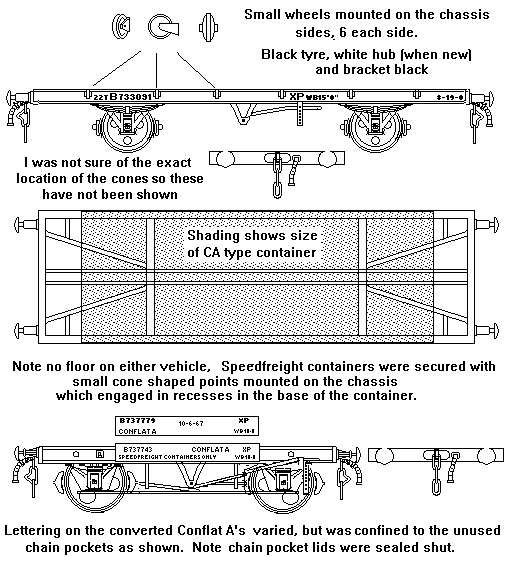
Although built for a limited London-Manchester service Speedfreight containers later appeared in Condor (London Glasgow) services and many of the containers were fitted with Freightliner lifting points (as described below) so they may have been used for other services.
The standard ISO container, originally 8 feet x 8 feet by multiples of 10 foot long, came into service in the early 60's. They were an American development and as the Americans do not use metric measurements the sizes are always described in feet and inches. Eight foot is 2.43m, eight foot six inches is 2.6m and the tallest currently in service are nine foot six inches or 2.9m, whilst the ten foot length translates to 3.04m.
British Railways did not initially own any ISO containers but when the boxes began appearing in some numbers at the ports they modified about a hundred Lowmac well wagons to carry a single 20 foot (6m) container each (see Fig___). Some plate wagons were also converted but these must have been on a restricted service as even the original standard eight foot high ISO container would foul the loading gauge on a normal height wagon. Purpose built bogie container carrying flats wagons appeared in 1964, fitted with smaller than usual wheels to reduce the overall height. The original official livery for the container flat itself was black, this changed to blue from about 1965, but the wagons soon become coated in brake dust so a going over with Humbrol track colour is in order.
The ISO rail container service is run by Freightliners Ltd. The Freightliner operation is discussed in detail in the section on Operations and their various container liveries are detailed in that section.
By the 1970's containers owned by international shipping firms and container hiring companies were becoming commonplace. The liveries of these containers are discussed under Private Owner Liveries below.
I understand that the yellow stripe indicating first class sections was adopted by BR in about 1961
Most pre-nationalisation companies indicated the 'class' of a compartment or coach by having a large numeral on the doors, some had 'First' and 'Third' written at the waist line, some had both (second class was very rare after 1900). The yellow stripe at the cantrail (near the top above the doors) to indicate first class compartments was introduced by the GER on London commuter lines in the 1920's as it was easier to see on crowded platforms). I believe the early BR southern region livery included the yellow stripe for London suburban services but other regions did not adopt the marking until about 1961 when a number of new liveries were being introduced for inter-city services. At this time the yellow stripe became standard, and a red stripe was added to the cantrail of catering vehicles.
Non passenger coaching stock such as horse boxes and parcels vans followed standard BR
coaching stock practice; non-corridor stock was initially painted plain crimson or
carmine (a pale red) body, sometimes with black ends. Some of the non passenger stock
equipped with corridor connections was painted plain carmine but some had the
carmine and cream of the main line coaches. The lettering was yellow in all
cases and the roofs were a dark grey, tending toward black in service.
Horse boxes seem to have remained in the carmine livery for most of their life before being withdrawn, receiving little use they lasted a long time between major overhauls. The standard British Railways horse box is not available as a ready to run model in N, but the N Gauge Society have now filled this gap with a very nice kit.
The numbering system for pre nationalisation parcels stock initially employed a prefix letter to indicate which company the stock came from, for example a GWR van number 123456 would become W123456. In the 1950's a suffix letter was added showing which British Railways region was responsible for maintaining the stock, these were usually but not always the same, the van would then be numbered W123456W. Stock delivered new to British Railways (including milk tanks) built to orders placed by the Big Four and built to pre-British Railways designs had the prefix letter 'B' only. This colour scheme lasted until the introduction of the Corporate Image `rail blue' in 1964.
Road vehicles, lorries and vans, were painted crimson with cream upper parts and white lettering. On some goods road vehicles the double-sausage logo with the words British Railways appeared on the sides.
